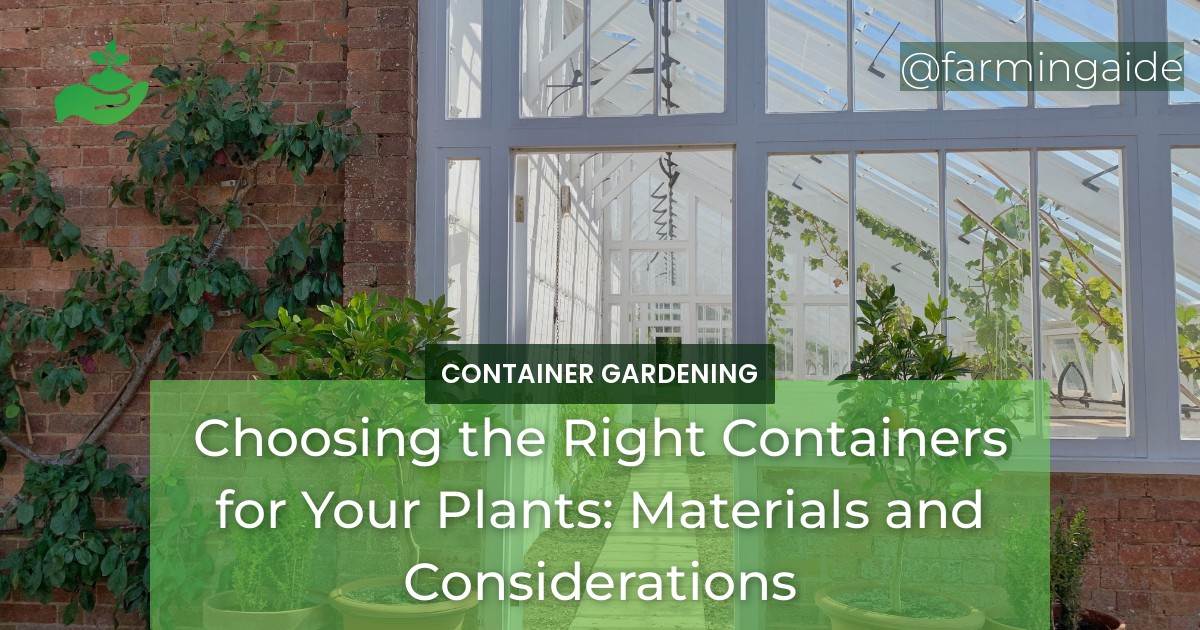Container gardening is an excellent way to bring the beauty of nature into your living space, even if you don’t have a yard. Choosing the right containers for your plants is important for the health and growth of your plants. There are many factors to consider, including plant size and type, climate and environment, aesthetics and design, budget, and durability. Additionally, the material of the container can have a significant impact on the growth and longevity of your plants.
In this article, we will explore the benefits of container gardening, factors to consider when choosing the right containers for your plants, the various container materials available, and the pros and cons of each material.
Table of Contents
Benefits of Container Gardening
Container gardening offers several advantages over traditional gardening methods. Here are a few benefits to consider:
- Allows gardening in small spaces, such as apartments or balconies
- Provides greater control over soil quality and moisture levels
- Eliminates the need for weeding
- Offers greater flexibility in plant placement, making it easier to maximize sun exposure and protect plants from harsh weather conditions
- Allows for easy relocation of plants as needed
Factors to Consider When Choosing Containers
Plant Size and Type
The size and type of plant you want to grow will play a significant role in choosing the right container. Some plants have extensive root systems that require deep containers, while others can thrive in shallow pots. Additionally, some plants prefer to be root-bound, while others require ample space for healthy growth.
Climate and Environment
The climate and environment in which you are growing your plants will also impact your container selection. For example, if you live in a hot, dry climate, you will want to choose containers that can withstand intense sunlight and heat without cracking or fading. If you live in a cold climate, you may need to choose containers that can withstand freezing temperatures without cracking.
Aesthetics and Design
The aesthetic appeal of your containers is also important. Your containers should complement your existing decor and enhance the overall look of your space. Additionally, the design of your containers can impact how well your plants grow. Containers that are too small or too large can cause problems with moisture levels and root growth.
Budget and Durability
Your budget and durability requirements will also play a role in choosing the right containers. Some materials, like plastic, are more affordable and durable than others, but they may not offer the same aesthetic appeal as other materials. Additionally, some materials, like terracotta, may be more delicate and require more care, but they offer a unique and beautiful look.
ALSO READ
Container Materials
There are several container materials to choose from, each with its own advantages and disadvantages. Here is a list of some of the most popular container materials:
- Plastic
- Terracotta
- Ceramic
- Metal
- Wood
- Concrete
Pros and Cons of Different Container Materials
Plastic
Plastic containers are lightweight, affordable, and durable. They are available in a variety of shapes and sizes and can be found in most gardening stores. However, plastic is not the most aesthetically pleasing material and can easily crack or fade when exposed to sunlight for extended periods.
Terracotta
Terracotta containers offer a unique and beautiful look and are ideal for plants that prefer a slightly dry environment. However, they are fragile and can break easily if dropped or exposed to harsh weather conditions. They are also porous, which can lead to moisture loss and require more frequent watering.
Ceramic
Ceramic containers are available in a variety of patterns, colors, and designs, making them an excellent choice for adding a decorative touch to your space. They are sturdy and long-lasting, but they can be heavy and are vulnerable to cracking or chipping if dropped or exposed to extreme temperatures.
Metal
Metal containers can add a modern and sleek look to your space. They are durable and weather-resistant, but they can become hot when exposed to sunlight and can heat the soil, which can be harmful to some plants. Additionally, they are prone to rust and corrosion and may require sealing or protective coatings to maintain their appearance.
Wood
Wooden containers offer a natural and rustic look and are ideal for plants that prefer a moist environment. However, they are susceptible to rot and decay and may require lining with plastic or other materials to prevent moisture damage. Additionally, they can be heavy and may require more frequent watering than other materials.
Concrete
Concrete containers are sturdy and long-lasting and can withstand extreme weather conditions. They are available in various shapes and sizes and can be found in most gardening stores. However, they can be heavy and difficult to move, and they may require sealing to prevent moisture damage.
ALSO READ
What Are the Best Types of Containers for Growing Shrubs in a Container Garden?
When it comes to growing shrubs in containers, it’s important to choose the right type of container. Large plastic or wooden containers with good drainage are ideal for growing shrubs in containers. Make sure the container is large enough for the shrub’s roots to spread out and thrive.
Conclusion
When it comes to choosing the right containers for your plants, there are many factors to consider, such as plant size and type, climate and environment, aesthetics and design, budget, and durability. Additionally, the material of the container can impact the growth and longevity of your plants. By considering all of these factors and exploring the various container materials available, you can find the perfect containers for your plants and create a beautiful and thriving indoor or outdoor garden.
RELATED ARTICLES:


